BSBPMG515: HRM Project Resource, Delegation, and Performance Analysis
VerifiedAdded on 2022/09/18
|9
|1879
|27
Homework Assignment
AI Summary
This assignment delves into the multifaceted realm of Human Resource Management (HRM) within a project context. It explores how different resource types, including people, finances, and equipment, influence project progress, emphasizing effective management and allocation strategies. The document outlines the process of determining the appropriate number of resources, including the creation of resource plans, quantifying requirements, and constructing management schedules. It also examines the project manager's role in assignment, delegation, and authorization functions, and the steps involved in training, development, and knowledge transfer within a project. Furthermore, the assignment details performance criteria expected of project team members and addresses key HRM principles, including motivation theories, organizational structures, and project management authorities. It also covers the factors influencing human resource planning and the importance of documentation and resource breakdown structures. The assignment concludes with a series of multiple-choice questions covering various aspects of project and human resource management.
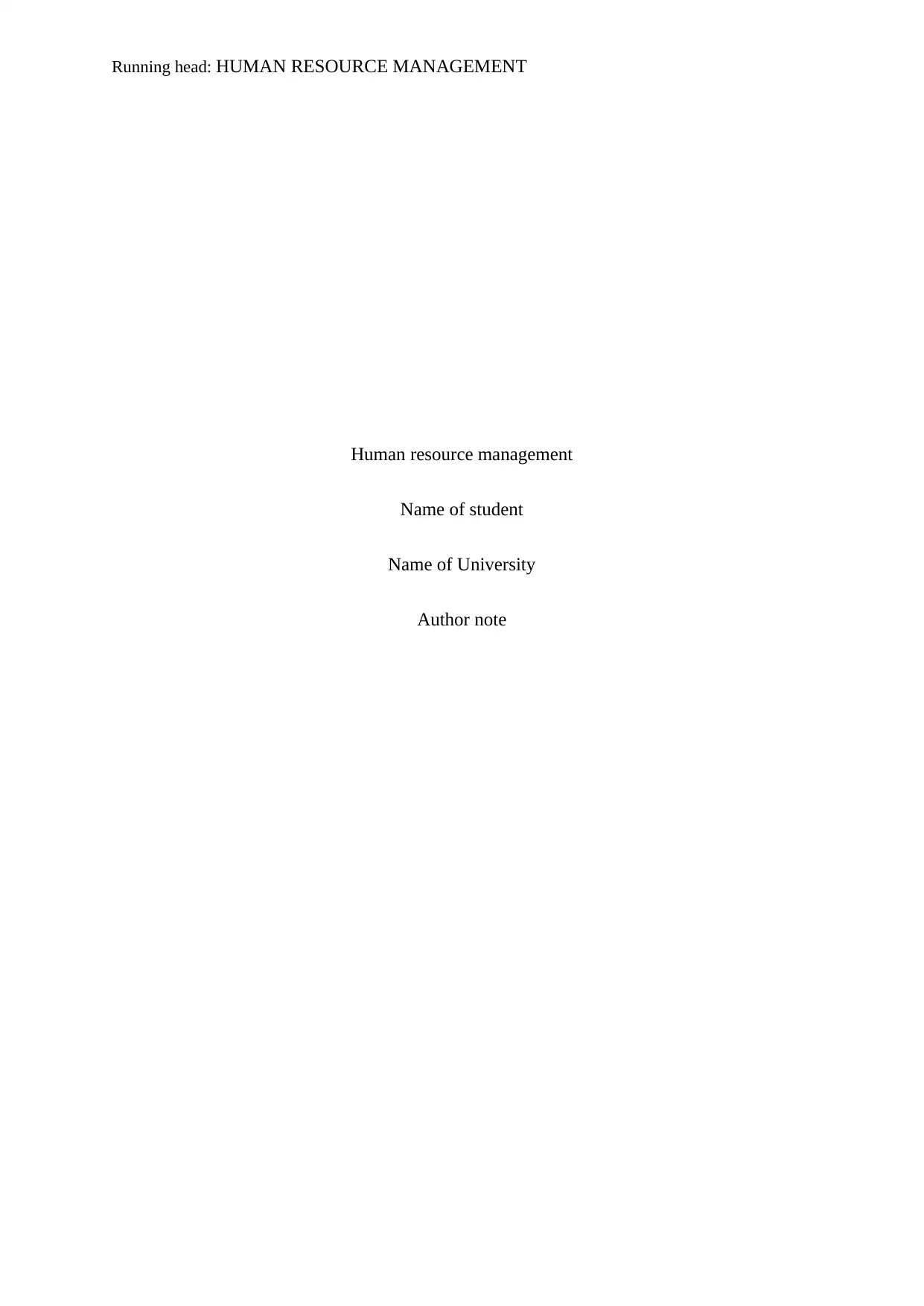
Running head: HUMAN RESOURCE MANAGEMENT
Human resource management
Name of student
Name of University
Author note
Human resource management
Name of student
Name of University
Author note
Paraphrase This Document
Need a fresh take? Get an instant paraphrase of this document with our AI Paraphraser
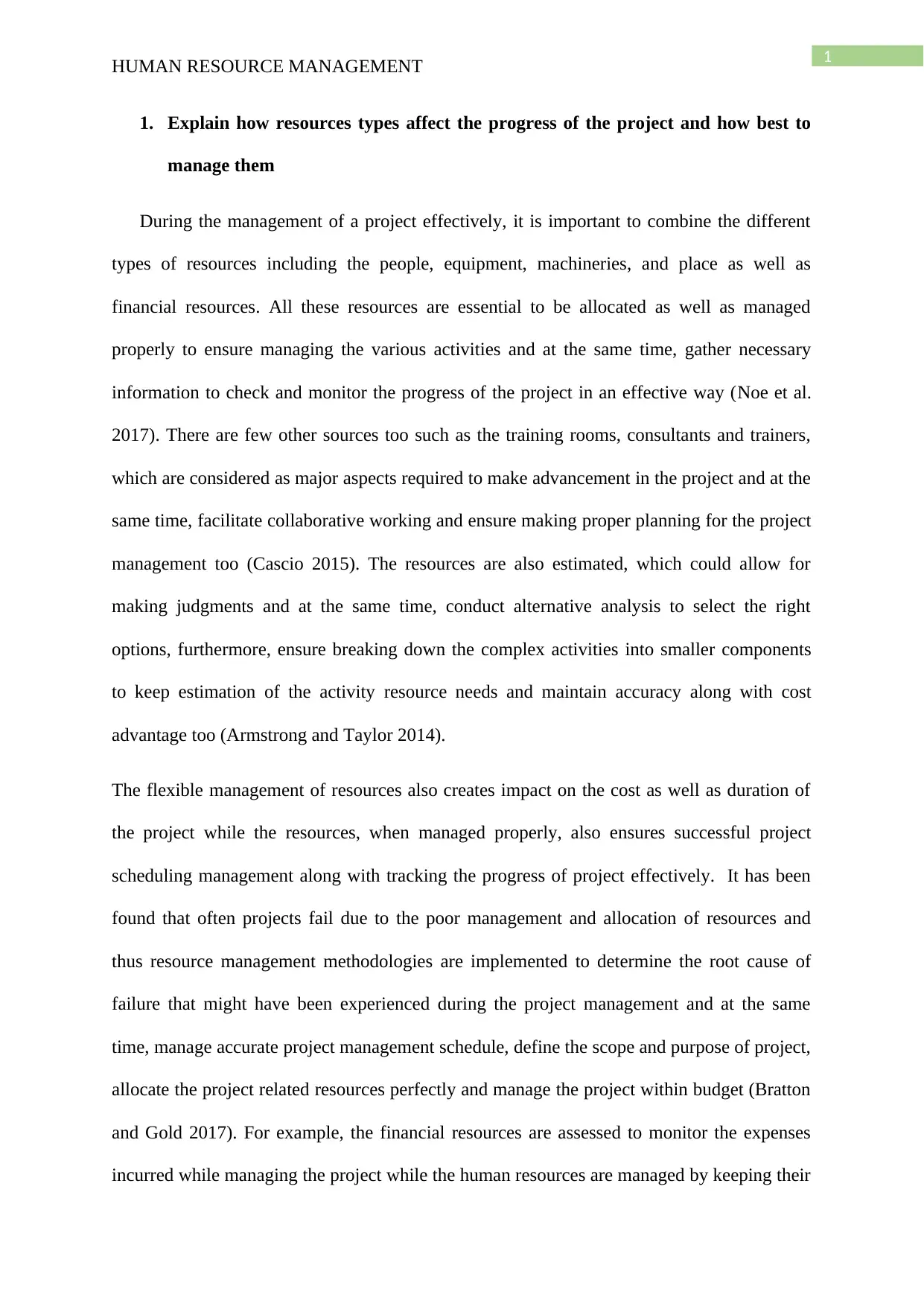
1
HUMAN RESOURCE MANAGEMENT
1. Explain how resources types affect the progress of the project and how best to
manage them
During the management of a project effectively, it is important to combine the different
types of resources including the people, equipment, machineries, and place as well as
financial resources. All these resources are essential to be allocated as well as managed
properly to ensure managing the various activities and at the same time, gather necessary
information to check and monitor the progress of the project in an effective way (Noe et al.
2017). There are few other sources too such as the training rooms, consultants and trainers,
which are considered as major aspects required to make advancement in the project and at the
same time, facilitate collaborative working and ensure making proper planning for the project
management too (Cascio 2015). The resources are also estimated, which could allow for
making judgments and at the same time, conduct alternative analysis to select the right
options, furthermore, ensure breaking down the complex activities into smaller components
to keep estimation of the activity resource needs and maintain accuracy along with cost
advantage too (Armstrong and Taylor 2014).
The flexible management of resources also creates impact on the cost as well as duration of
the project while the resources, when managed properly, also ensures successful project
scheduling management along with tracking the progress of project effectively. It has been
found that often projects fail due to the poor management and allocation of resources and
thus resource management methodologies are implemented to determine the root cause of
failure that might have been experienced during the project management and at the same
time, manage accurate project management schedule, define the scope and purpose of project,
allocate the project related resources perfectly and manage the project within budget (Bratton
and Gold 2017). For example, the financial resources are assessed to monitor the expenses
incurred while managing the project while the human resources are managed by keeping their
HUMAN RESOURCE MANAGEMENT
1. Explain how resources types affect the progress of the project and how best to
manage them
During the management of a project effectively, it is important to combine the different
types of resources including the people, equipment, machineries, and place as well as
financial resources. All these resources are essential to be allocated as well as managed
properly to ensure managing the various activities and at the same time, gather necessary
information to check and monitor the progress of the project in an effective way (Noe et al.
2017). There are few other sources too such as the training rooms, consultants and trainers,
which are considered as major aspects required to make advancement in the project and at the
same time, facilitate collaborative working and ensure making proper planning for the project
management too (Cascio 2015). The resources are also estimated, which could allow for
making judgments and at the same time, conduct alternative analysis to select the right
options, furthermore, ensure breaking down the complex activities into smaller components
to keep estimation of the activity resource needs and maintain accuracy along with cost
advantage too (Armstrong and Taylor 2014).
The flexible management of resources also creates impact on the cost as well as duration of
the project while the resources, when managed properly, also ensures successful project
scheduling management along with tracking the progress of project effectively. It has been
found that often projects fail due to the poor management and allocation of resources and
thus resource management methodologies are implemented to determine the root cause of
failure that might have been experienced during the project management and at the same
time, manage accurate project management schedule, define the scope and purpose of project,
allocate the project related resources perfectly and manage the project within budget (Bratton
and Gold 2017). For example, the financial resources are assessed to monitor the expenses
incurred while managing the project while the human resources are managed by keeping their
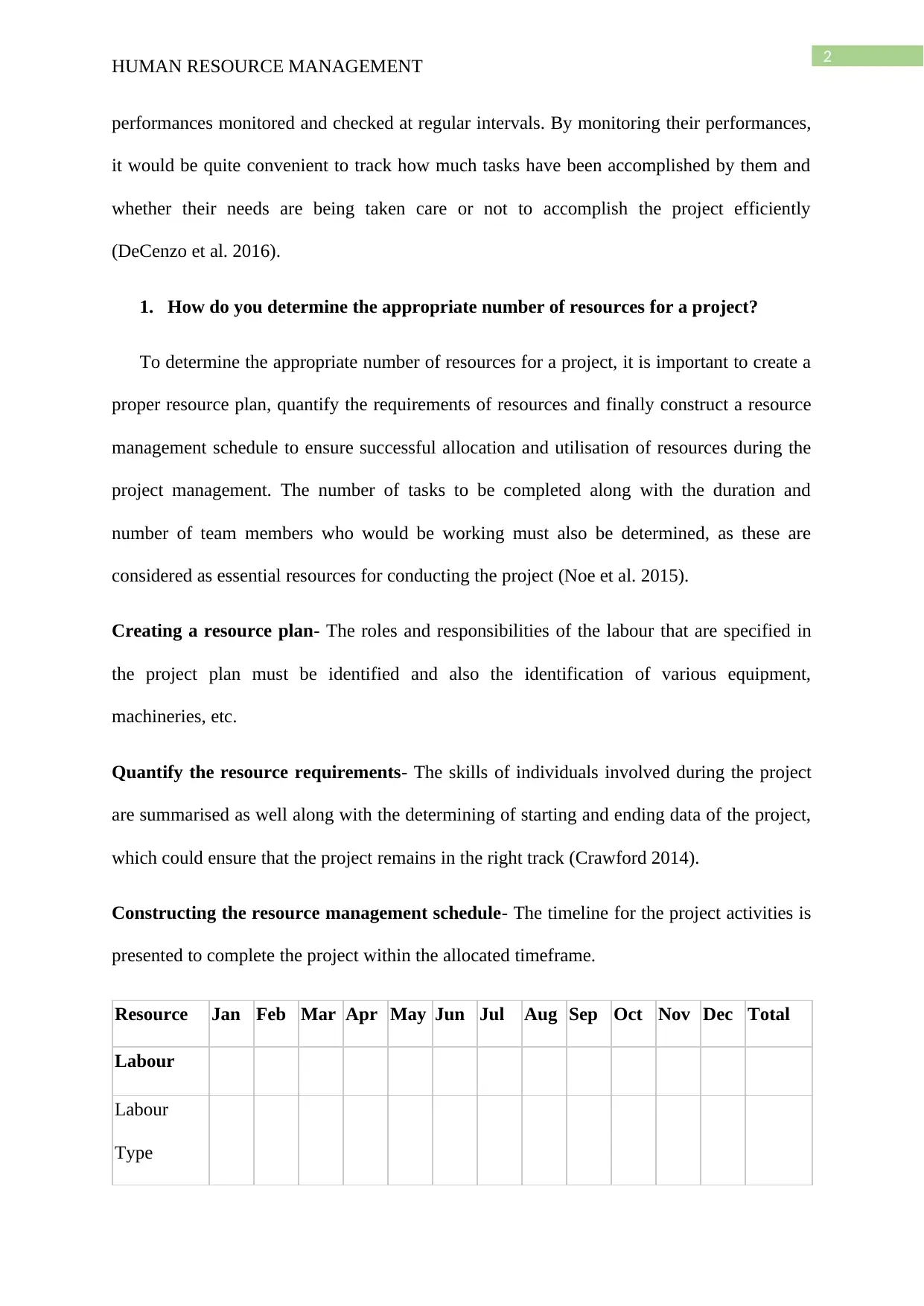
2
HUMAN RESOURCE MANAGEMENT
performances monitored and checked at regular intervals. By monitoring their performances,
it would be quite convenient to track how much tasks have been accomplished by them and
whether their needs are being taken care or not to accomplish the project efficiently
(DeCenzo et al. 2016).
1. How do you determine the appropriate number of resources for a project?
To determine the appropriate number of resources for a project, it is important to create a
proper resource plan, quantify the requirements of resources and finally construct a resource
management schedule to ensure successful allocation and utilisation of resources during the
project management. The number of tasks to be completed along with the duration and
number of team members who would be working must also be determined, as these are
considered as essential resources for conducting the project (Noe et al. 2015).
Creating a resource plan- The roles and responsibilities of the labour that are specified in
the project plan must be identified and also the identification of various equipment,
machineries, etc.
Quantify the resource requirements- The skills of individuals involved during the project
are summarised as well along with the determining of starting and ending data of the project,
which could ensure that the project remains in the right track (Crawford 2014).
Constructing the resource management schedule- The timeline for the project activities is
presented to complete the project within the allocated timeframe.
Resource Jan Feb Mar Apr May Jun Jul Aug Sep Oct Nov Dec Total
Labour
Labour
Type
HUMAN RESOURCE MANAGEMENT
performances monitored and checked at regular intervals. By monitoring their performances,
it would be quite convenient to track how much tasks have been accomplished by them and
whether their needs are being taken care or not to accomplish the project efficiently
(DeCenzo et al. 2016).
1. How do you determine the appropriate number of resources for a project?
To determine the appropriate number of resources for a project, it is important to create a
proper resource plan, quantify the requirements of resources and finally construct a resource
management schedule to ensure successful allocation and utilisation of resources during the
project management. The number of tasks to be completed along with the duration and
number of team members who would be working must also be determined, as these are
considered as essential resources for conducting the project (Noe et al. 2015).
Creating a resource plan- The roles and responsibilities of the labour that are specified in
the project plan must be identified and also the identification of various equipment,
machineries, etc.
Quantify the resource requirements- The skills of individuals involved during the project
are summarised as well along with the determining of starting and ending data of the project,
which could ensure that the project remains in the right track (Crawford 2014).
Constructing the resource management schedule- The timeline for the project activities is
presented to complete the project within the allocated timeframe.
Resource Jan Feb Mar Apr May Jun Jul Aug Sep Oct Nov Dec Total
Labour
Labour
Type
⊘ This is a preview!⊘
Do you want full access?
Subscribe today to unlock all pages.

Trusted by 1+ million students worldwide
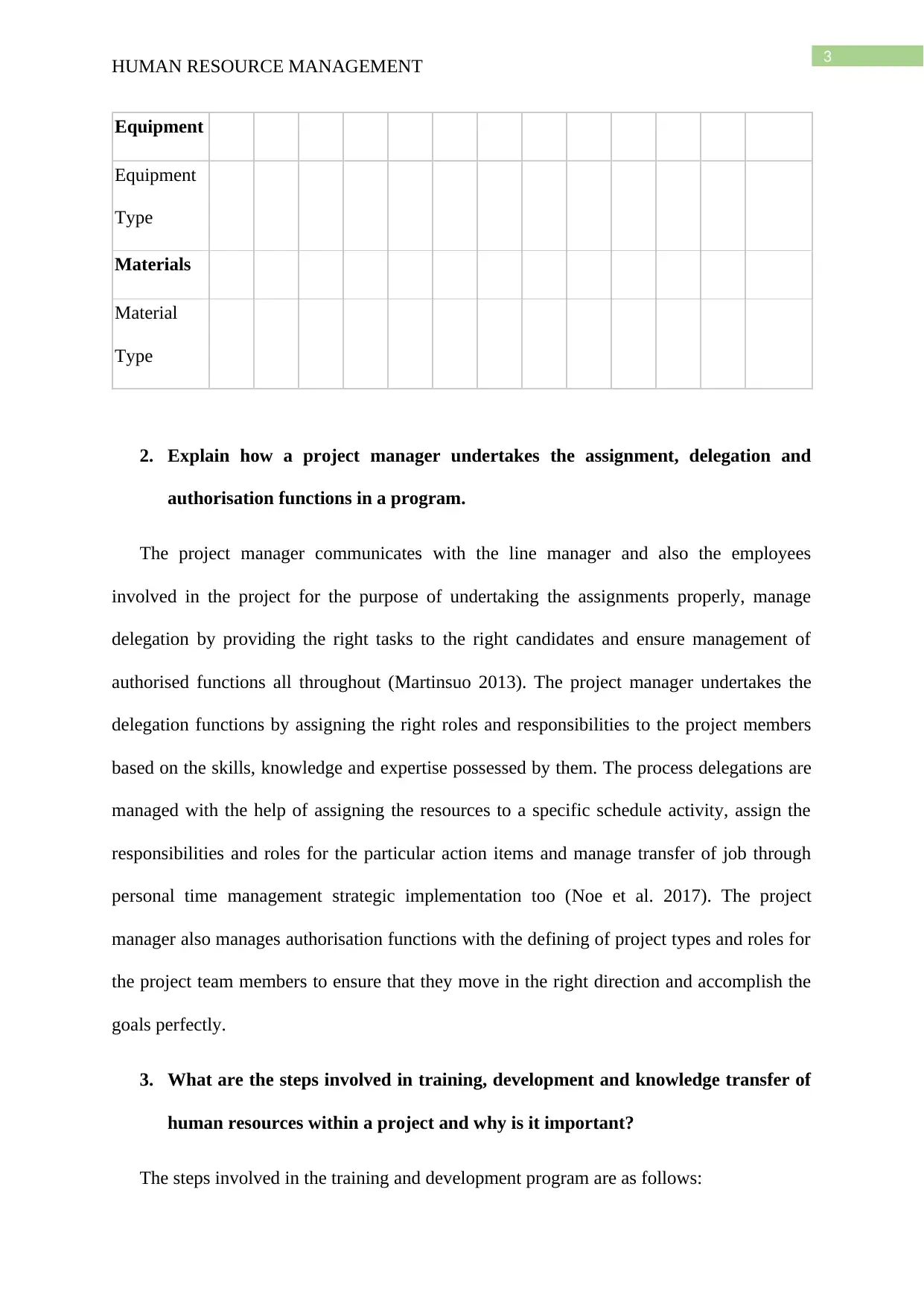
3
HUMAN RESOURCE MANAGEMENT
Equipment
Equipment
Type
Materials
Material
Type
2. Explain how a project manager undertakes the assignment, delegation and
authorisation functions in a program.
The project manager communicates with the line manager and also the employees
involved in the project for the purpose of undertaking the assignments properly, manage
delegation by providing the right tasks to the right candidates and ensure management of
authorised functions all throughout (Martinsuo 2013). The project manager undertakes the
delegation functions by assigning the right roles and responsibilities to the project members
based on the skills, knowledge and expertise possessed by them. The process delegations are
managed with the help of assigning the resources to a specific schedule activity, assign the
responsibilities and roles for the particular action items and manage transfer of job through
personal time management strategic implementation too (Noe et al. 2017). The project
manager also manages authorisation functions with the defining of project types and roles for
the project team members to ensure that they move in the right direction and accomplish the
goals perfectly.
3. What are the steps involved in training, development and knowledge transfer of
human resources within a project and why is it important?
The steps involved in the training and development program are as follows:
HUMAN RESOURCE MANAGEMENT
Equipment
Equipment
Type
Materials
Material
Type
2. Explain how a project manager undertakes the assignment, delegation and
authorisation functions in a program.
The project manager communicates with the line manager and also the employees
involved in the project for the purpose of undertaking the assignments properly, manage
delegation by providing the right tasks to the right candidates and ensure management of
authorised functions all throughout (Martinsuo 2013). The project manager undertakes the
delegation functions by assigning the right roles and responsibilities to the project members
based on the skills, knowledge and expertise possessed by them. The process delegations are
managed with the help of assigning the resources to a specific schedule activity, assign the
responsibilities and roles for the particular action items and manage transfer of job through
personal time management strategic implementation too (Noe et al. 2017). The project
manager also manages authorisation functions with the defining of project types and roles for
the project team members to ensure that they move in the right direction and accomplish the
goals perfectly.
3. What are the steps involved in training, development and knowledge transfer of
human resources within a project and why is it important?
The steps involved in the training and development program are as follows:
Paraphrase This Document
Need a fresh take? Get an instant paraphrase of this document with our AI Paraphraser
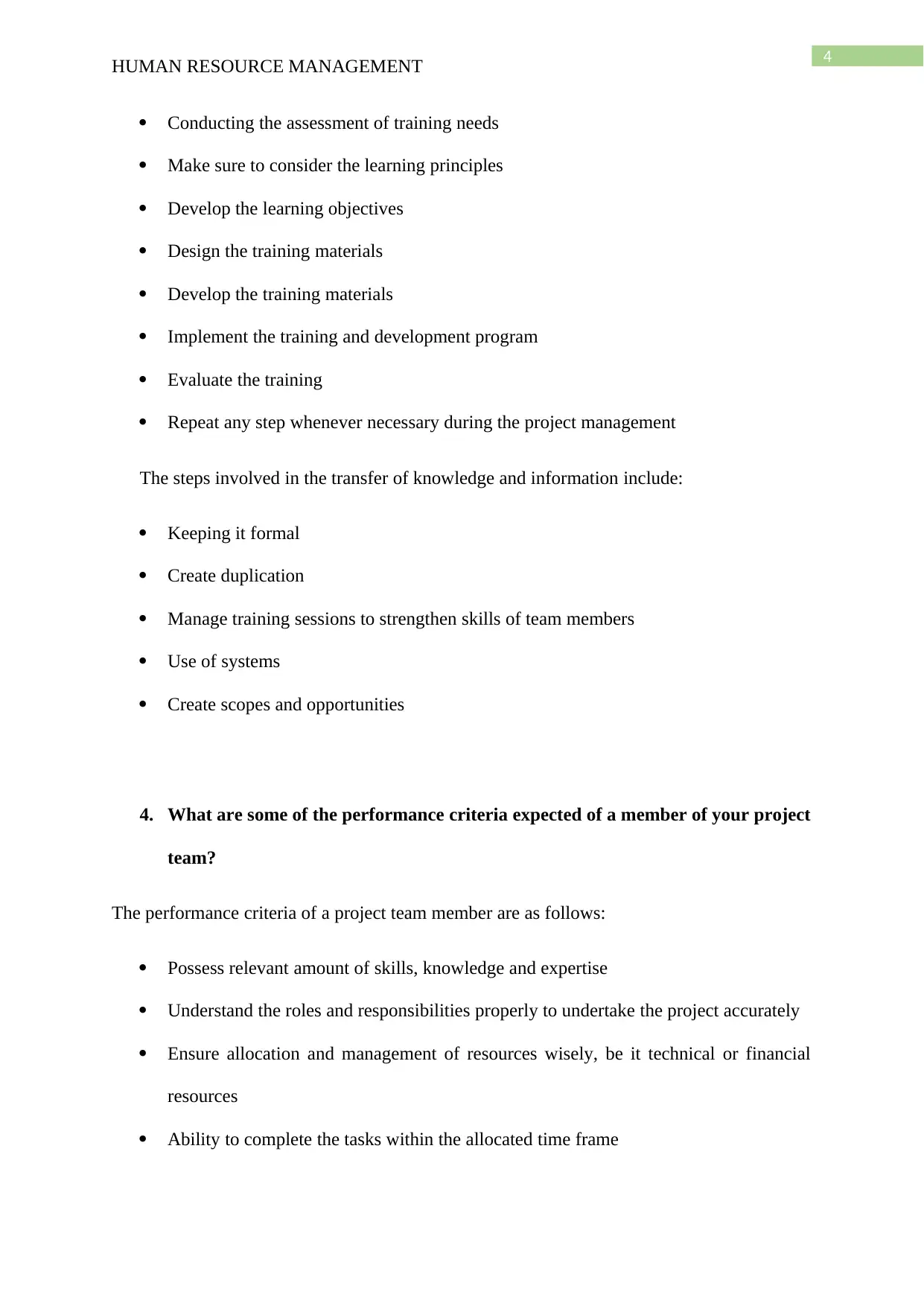
4
HUMAN RESOURCE MANAGEMENT
Conducting the assessment of training needs
Make sure to consider the learning principles
Develop the learning objectives
Design the training materials
Develop the training materials
Implement the training and development program
Evaluate the training
Repeat any step whenever necessary during the project management
The steps involved in the transfer of knowledge and information include:
Keeping it formal
Create duplication
Manage training sessions to strengthen skills of team members
Use of systems
Create scopes and opportunities
4. What are some of the performance criteria expected of a member of your project
team?
The performance criteria of a project team member are as follows:
Possess relevant amount of skills, knowledge and expertise
Understand the roles and responsibilities properly to undertake the project accurately
Ensure allocation and management of resources wisely, be it technical or financial
resources
Ability to complete the tasks within the allocated time frame
HUMAN RESOURCE MANAGEMENT
Conducting the assessment of training needs
Make sure to consider the learning principles
Develop the learning objectives
Design the training materials
Develop the training materials
Implement the training and development program
Evaluate the training
Repeat any step whenever necessary during the project management
The steps involved in the transfer of knowledge and information include:
Keeping it formal
Create duplication
Manage training sessions to strengthen skills of team members
Use of systems
Create scopes and opportunities
4. What are some of the performance criteria expected of a member of your project
team?
The performance criteria of a project team member are as follows:
Possess relevant amount of skills, knowledge and expertise
Understand the roles and responsibilities properly to undertake the project accurately
Ensure allocation and management of resources wisely, be it technical or financial
resources
Ability to complete the tasks within the allocated time frame
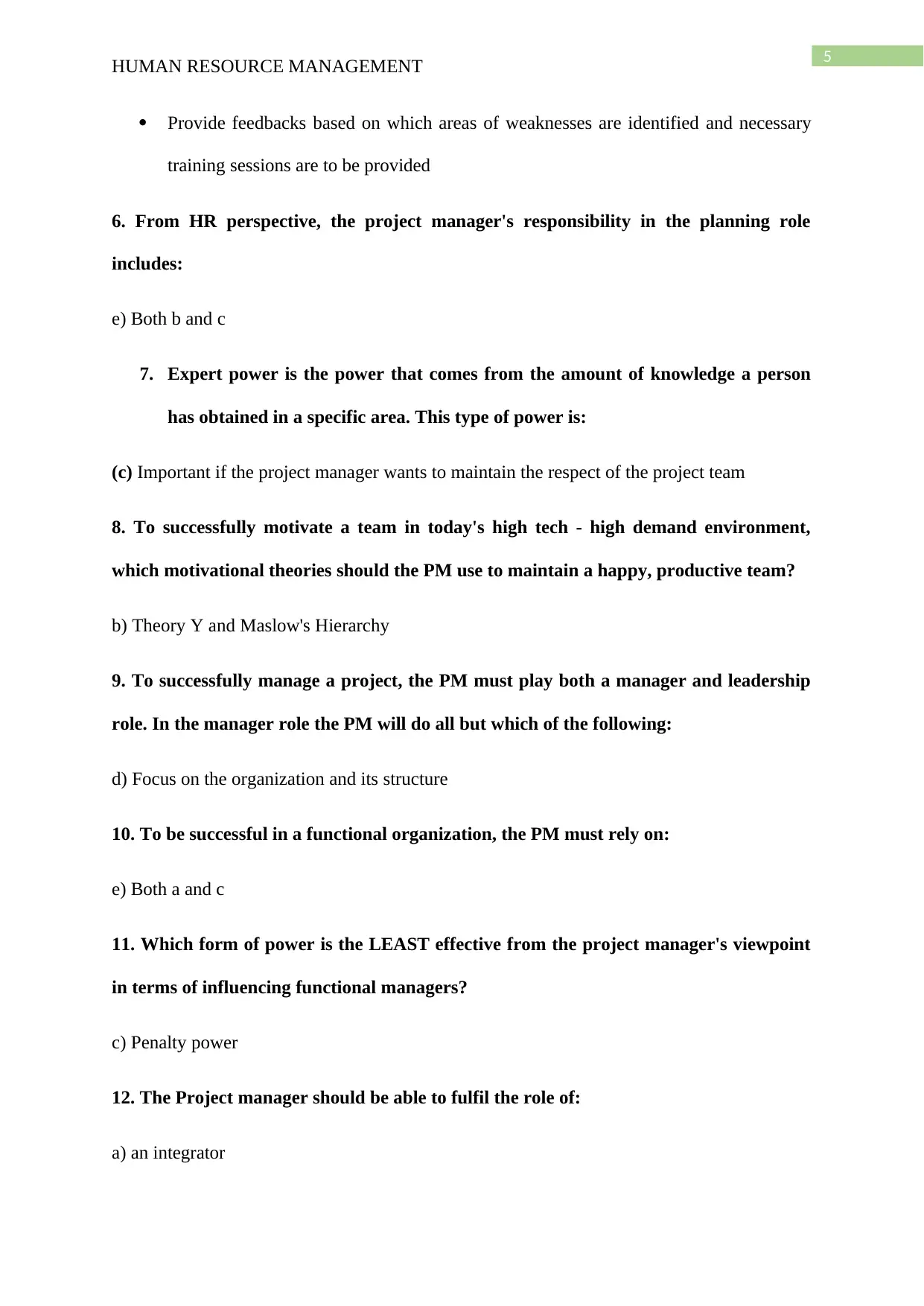
5
HUMAN RESOURCE MANAGEMENT
Provide feedbacks based on which areas of weaknesses are identified and necessary
training sessions are to be provided
6. From HR perspective, the project manager's responsibility in the planning role
includes:
e) Both b and c
7. Expert power is the power that comes from the amount of knowledge a person
has obtained in a specific area. This type of power is:
(c) Important if the project manager wants to maintain the respect of the project team
8. To successfully motivate a team in today's high tech - high demand environment,
which motivational theories should the PM use to maintain a happy, productive team?
b) Theory Y and Maslow's Hierarchy
9. To successfully manage a project, the PM must play both a manager and leadership
role. In the manager role the PM will do all but which of the following:
d) Focus on the organization and its structure
10. To be successful in a functional organization, the PM must rely on:
e) Both a and c
11. Which form of power is the LEAST effective from the project manager's viewpoint
in terms of influencing functional managers?
c) Penalty power
12. The Project manager should be able to fulfil the role of:
a) an integrator
HUMAN RESOURCE MANAGEMENT
Provide feedbacks based on which areas of weaknesses are identified and necessary
training sessions are to be provided
6. From HR perspective, the project manager's responsibility in the planning role
includes:
e) Both b and c
7. Expert power is the power that comes from the amount of knowledge a person
has obtained in a specific area. This type of power is:
(c) Important if the project manager wants to maintain the respect of the project team
8. To successfully motivate a team in today's high tech - high demand environment,
which motivational theories should the PM use to maintain a happy, productive team?
b) Theory Y and Maslow's Hierarchy
9. To successfully manage a project, the PM must play both a manager and leadership
role. In the manager role the PM will do all but which of the following:
d) Focus on the organization and its structure
10. To be successful in a functional organization, the PM must rely on:
e) Both a and c
11. Which form of power is the LEAST effective from the project manager's viewpoint
in terms of influencing functional managers?
c) Penalty power
12. The Project manager should be able to fulfil the role of:
a) an integrator
⊘ This is a preview!⊘
Do you want full access?
Subscribe today to unlock all pages.

Trusted by 1+ million students worldwide
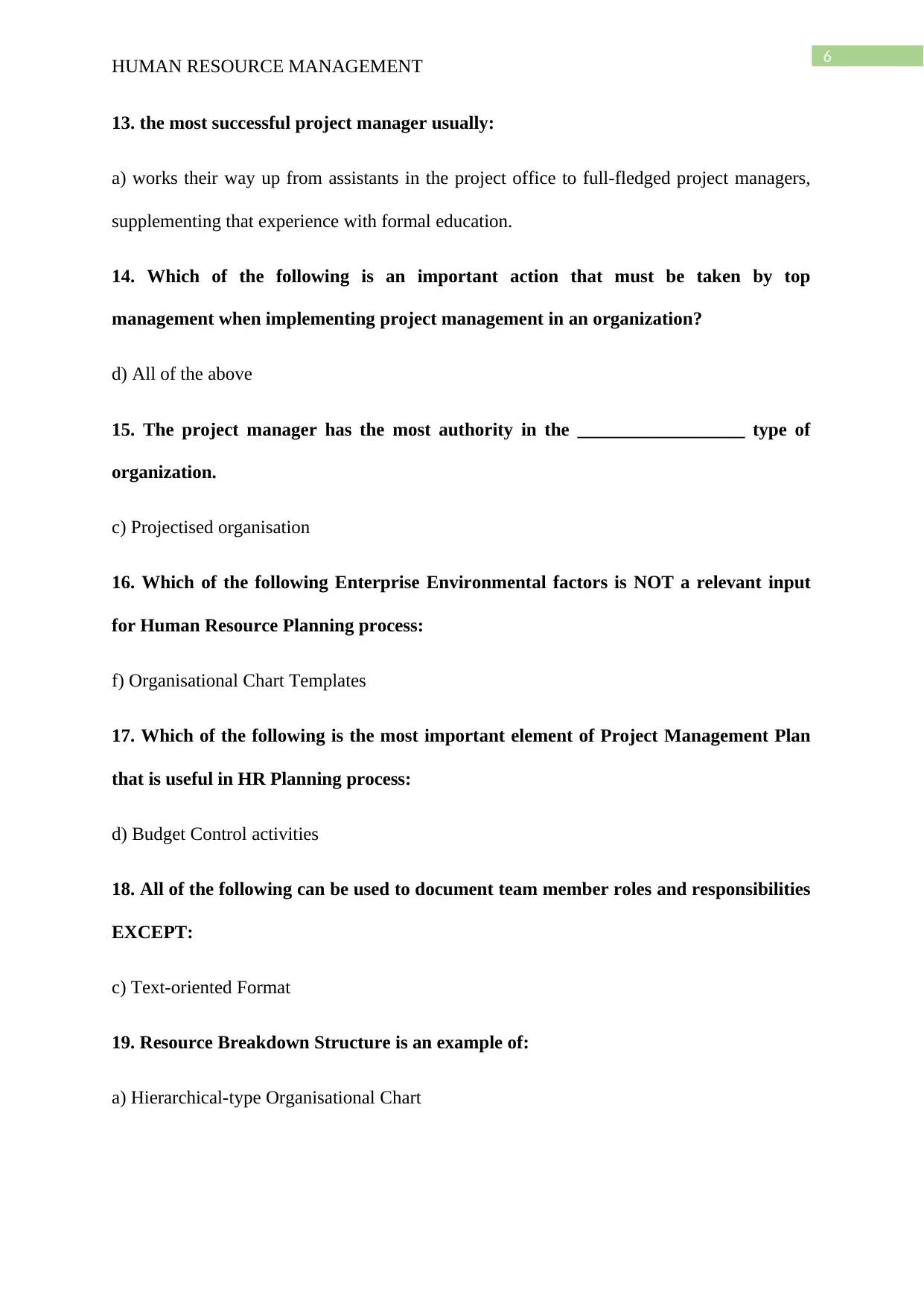
6
HUMAN RESOURCE MANAGEMENT
13. the most successful project manager usually:
a) works their way up from assistants in the project office to full-fledged project managers,
supplementing that experience with formal education.
14. Which of the following is an important action that must be taken by top
management when implementing project management in an organization?
d) All of the above
15. The project manager has the most authority in the __________________ type of
organization.
c) Projectised organisation
16. Which of the following Enterprise Environmental factors is NOT a relevant input
for Human Resource Planning process:
f) Organisational Chart Templates
17. Which of the following is the most important element of Project Management Plan
that is useful in HR Planning process:
d) Budget Control activities
18. All of the following can be used to document team member roles and responsibilities
EXCEPT:
c) Text-oriented Format
19. Resource Breakdown Structure is an example of:
a) Hierarchical-type Organisational Chart
HUMAN RESOURCE MANAGEMENT
13. the most successful project manager usually:
a) works their way up from assistants in the project office to full-fledged project managers,
supplementing that experience with formal education.
14. Which of the following is an important action that must be taken by top
management when implementing project management in an organization?
d) All of the above
15. The project manager has the most authority in the __________________ type of
organization.
c) Projectised organisation
16. Which of the following Enterprise Environmental factors is NOT a relevant input
for Human Resource Planning process:
f) Organisational Chart Templates
17. Which of the following is the most important element of Project Management Plan
that is useful in HR Planning process:
d) Budget Control activities
18. All of the following can be used to document team member roles and responsibilities
EXCEPT:
c) Text-oriented Format
19. Resource Breakdown Structure is an example of:
a) Hierarchical-type Organisational Chart
Paraphrase This Document
Need a fresh take? Get an instant paraphrase of this document with our AI Paraphraser
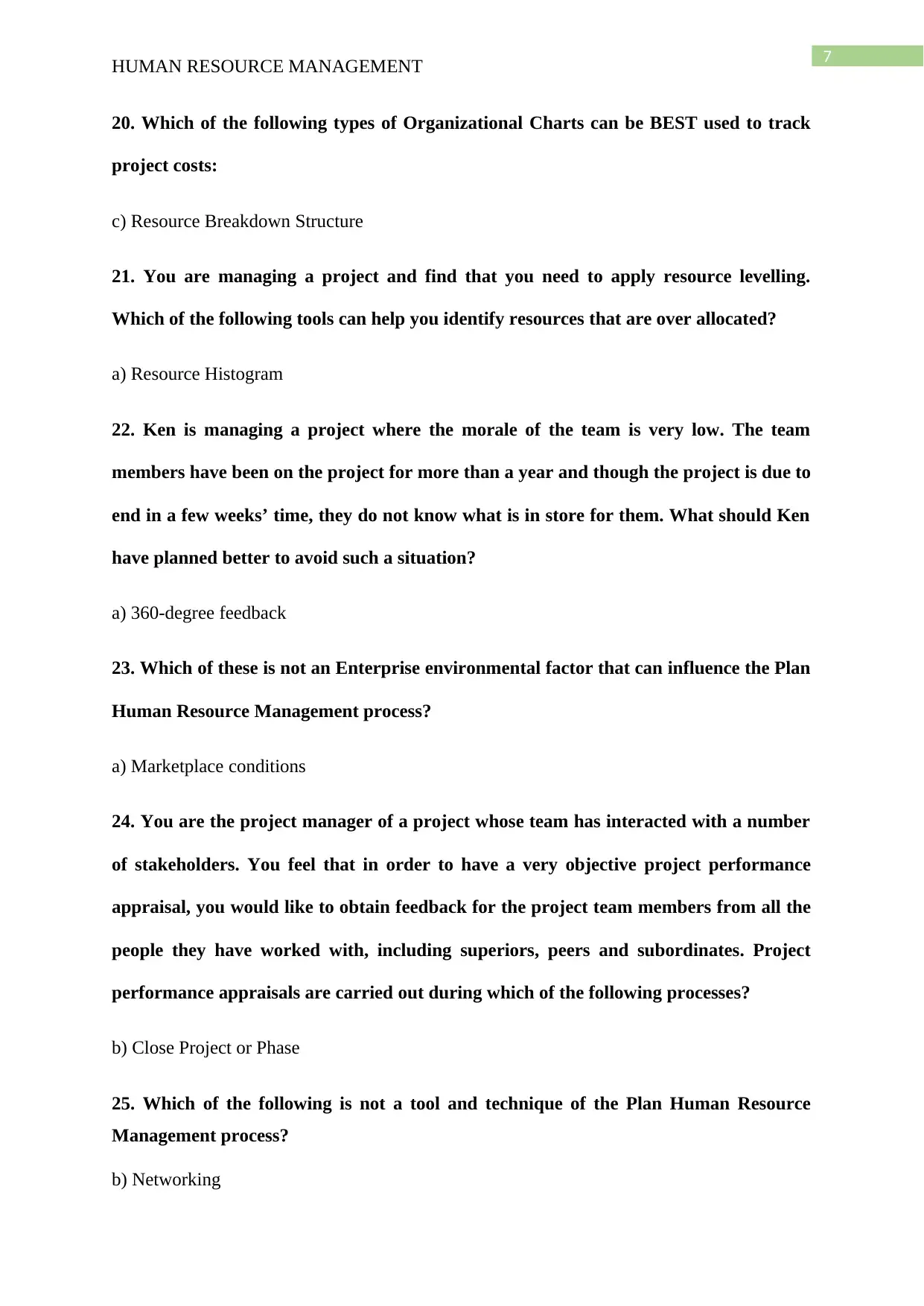
7
HUMAN RESOURCE MANAGEMENT
20. Which of the following types of Organizational Charts can be BEST used to track
project costs:
c) Resource Breakdown Structure
21. You are managing a project and find that you need to apply resource levelling.
Which of the following tools can help you identify resources that are over allocated?
a) Resource Histogram
22. Ken is managing a project where the morale of the team is very low. The team
members have been on the project for more than a year and though the project is due to
end in a few weeks’ time, they do not know what is in store for them. What should Ken
have planned better to avoid such a situation?
a) 360-degree feedback
23. Which of these is not an Enterprise environmental factor that can influence the Plan
Human Resource Management process?
a) Marketplace conditions
24. You are the project manager of a project whose team has interacted with a number
of stakeholders. You feel that in order to have a very objective project performance
appraisal, you would like to obtain feedback for the project team members from all the
people they have worked with, including superiors, peers and subordinates. Project
performance appraisals are carried out during which of the following processes?
b) Close Project or Phase
25. Which of the following is not a tool and technique of the Plan Human Resource
Management process?
b) Networking
HUMAN RESOURCE MANAGEMENT
20. Which of the following types of Organizational Charts can be BEST used to track
project costs:
c) Resource Breakdown Structure
21. You are managing a project and find that you need to apply resource levelling.
Which of the following tools can help you identify resources that are over allocated?
a) Resource Histogram
22. Ken is managing a project where the morale of the team is very low. The team
members have been on the project for more than a year and though the project is due to
end in a few weeks’ time, they do not know what is in store for them. What should Ken
have planned better to avoid such a situation?
a) 360-degree feedback
23. Which of these is not an Enterprise environmental factor that can influence the Plan
Human Resource Management process?
a) Marketplace conditions
24. You are the project manager of a project whose team has interacted with a number
of stakeholders. You feel that in order to have a very objective project performance
appraisal, you would like to obtain feedback for the project team members from all the
people they have worked with, including superiors, peers and subordinates. Project
performance appraisals are carried out during which of the following processes?
b) Close Project or Phase
25. Which of the following is not a tool and technique of the Plan Human Resource
Management process?
b) Networking
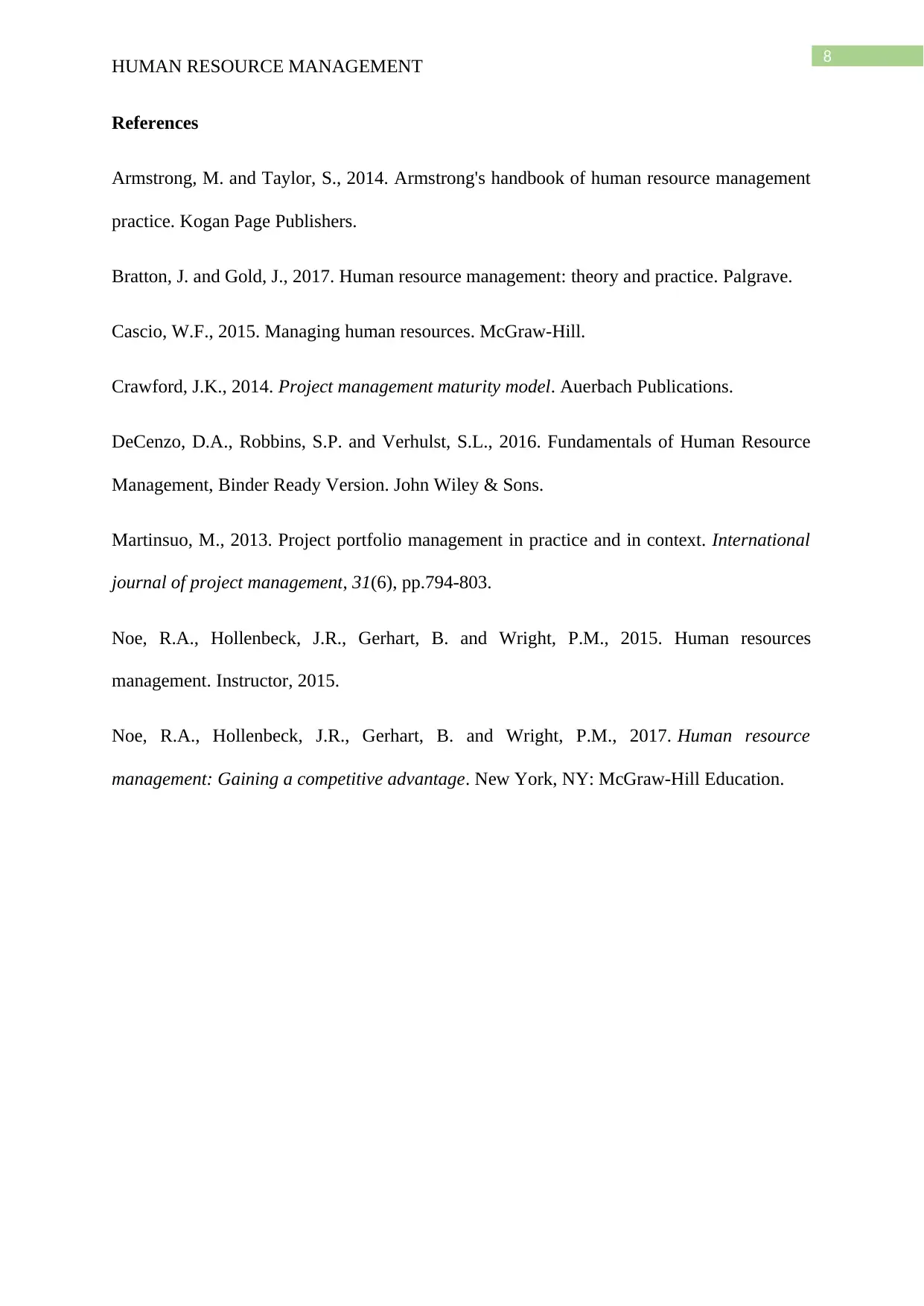
8
HUMAN RESOURCE MANAGEMENT
References
Armstrong, M. and Taylor, S., 2014. Armstrong's handbook of human resource management
practice. Kogan Page Publishers.
Bratton, J. and Gold, J., 2017. Human resource management: theory and practice. Palgrave.
Cascio, W.F., 2015. Managing human resources. McGraw-Hill.
Crawford, J.K., 2014. Project management maturity model. Auerbach Publications.
DeCenzo, D.A., Robbins, S.P. and Verhulst, S.L., 2016. Fundamentals of Human Resource
Management, Binder Ready Version. John Wiley & Sons.
Martinsuo, M., 2013. Project portfolio management in practice and in context. International
journal of project management, 31(6), pp.794-803.
Noe, R.A., Hollenbeck, J.R., Gerhart, B. and Wright, P.M., 2015. Human resources
management. Instructor, 2015.
Noe, R.A., Hollenbeck, J.R., Gerhart, B. and Wright, P.M., 2017. Human resource
management: Gaining a competitive advantage. New York, NY: McGraw-Hill Education.
HUMAN RESOURCE MANAGEMENT
References
Armstrong, M. and Taylor, S., 2014. Armstrong's handbook of human resource management
practice. Kogan Page Publishers.
Bratton, J. and Gold, J., 2017. Human resource management: theory and practice. Palgrave.
Cascio, W.F., 2015. Managing human resources. McGraw-Hill.
Crawford, J.K., 2014. Project management maturity model. Auerbach Publications.
DeCenzo, D.A., Robbins, S.P. and Verhulst, S.L., 2016. Fundamentals of Human Resource
Management, Binder Ready Version. John Wiley & Sons.
Martinsuo, M., 2013. Project portfolio management in practice and in context. International
journal of project management, 31(6), pp.794-803.
Noe, R.A., Hollenbeck, J.R., Gerhart, B. and Wright, P.M., 2015. Human resources
management. Instructor, 2015.
Noe, R.A., Hollenbeck, J.R., Gerhart, B. and Wright, P.M., 2017. Human resource
management: Gaining a competitive advantage. New York, NY: McGraw-Hill Education.
⊘ This is a preview!⊘
Do you want full access?
Subscribe today to unlock all pages.

Trusted by 1+ million students worldwide
1 out of 9
Related Documents
Your All-in-One AI-Powered Toolkit for Academic Success.
+13062052269
info@desklib.com
Available 24*7 on WhatsApp / Email
![[object Object]](/_next/static/media/star-bottom.7253800d.svg)
Unlock your academic potential
Copyright © 2020–2025 A2Z Services. All Rights Reserved. Developed and managed by ZUCOL.





